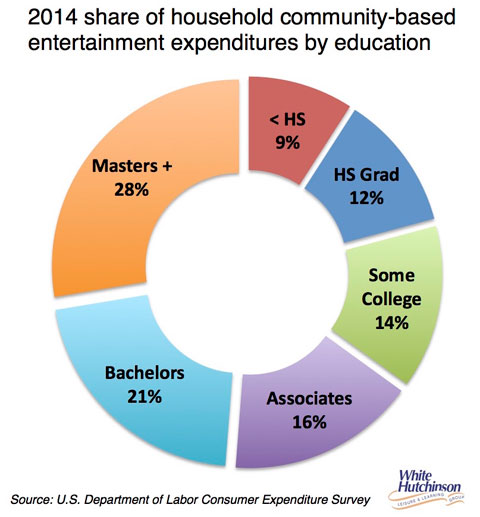
Vol. XVI, No. 3, March 2016
- Editor's corner
- Why do our eNewsletters have so much statistics?
- The four ways eatertainment can grow an LBE business
- Registration available for June Foundations Entertainment University
- Do you really know who your competition is?
- The truth about Hollywood's box office numbers
- Education and SELs are better predictors
- Bunkering; cocooning goes extreme
- The latest scoop on pizza
Education and SELs are better predictors
Most people typically use household incomes to examine market areas to determine their potentials. However, education is a far better predictor as it has a more direct relationship to values and tastes. It also has a significant relationship to spending at community-based entertainment venues (CBEs) of all types, including family entertainment centers (FECs).

In 2014, households that had one member with a Bachelor's or professional college degree accounted for almost one-half (49%) of all spending at CBEs. If we add in associate degrees, that larger group of college graduates accounted for almost two-thirds (65%) of all spending at CBEs.
When our company conducts market feasibility studies, we not only look at the income and education characteristics of the population, but we also use an even better analysis tool, socioeconomic-lifestyle groups (SELs). SELs classify the population by not only demographics, but also by their lifestyles, values, behaviors and spending. Different SELs have different tastes, values and expectations. SELs are far superior predictors of people's behaviors as consumers. Demographics are not.
Just saying you are targeting families or targeting adults is way too broad a target if you want to build a brand identity that will attract a segment of the population on a regular basis. Trying to be all things to all people never works. You want to become special to a select segment of the population, and that requires more than just having an age target.
Analyzing the SELs of a CBE's market area is critical to the success of developing and operating any CBE. Different SELs have different tastes, values and expectations. Different SELs have different spending preferences and expenditure levels for entertainment and food away-from-home. Market areas are rarely homogenous with only one or two SELs. There will be a variety. Certain groupings with similar traits need to be targeted if you wish to have high appeal to them. A CBE's design and operations, its entire brand identity needs to be matched to a targeted group of SELs to have the highest appeal, per capita spending and repeat business. Yes, the interior and exterior design, the mix of attractions, the menu, the pricing, the type and quality of customer service, everything about the CBE, its operations and marketing needs to be matched to the target SELs in order to be successful.
Here's a condensed description of just two different SEL families with children groups to give you an idea of how different SELs can be:
- Fast-Track Families: With their upper-middle-class incomes, numerous children and spacious homes, Fast-Track Families are in their prime acquisition years. These middle-aged parents have the disposable income and educated sensibility to want the best for their children. They buy the latest technology with impunity: new computers, DVD players, home theater systems and video games. They take advantage of their rustic locales by camping, boating and fishing.
- Family Thrifts: These lower-income households contain young, ethnically diverse parents who have lots of children and work entry-level service jobs. In these apartment-filled neighborhoods, visitors find the streets jam-packed with babies and toddlers, tricycles and basketball hoops, Suzukis and Kias.
It is impossible to successfully target both of these family SELs at the same CBE, as each has diversely different tastes, values, preferences and behaviors, including what they spend money on. To be successful, you would want to target Fast-Track Families, as they are the ones with the highest spending potential.
Location, location, location is important to any CBE's success. However, with location comes understanding its market area's SELs and then customizing the CBE to a targeted grouping of SELs to have the greatest success.
Vol. XVI, No. 3, March 2016
- Editor's corner
- Why do our eNewsletters have so much statistics?
- The four ways eatertainment can grow an LBE business
- Registration available for June Foundations Entertainment University
- Do you really know who your competition is?
- The truth about Hollywood's box office numbers
- Education and SELs are better predictors
- Bunkering; cocooning goes extreme
- The latest scoop on pizza


